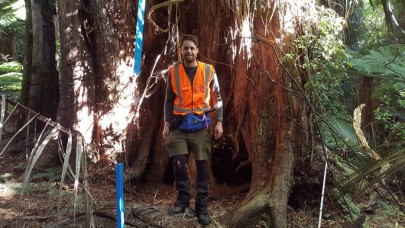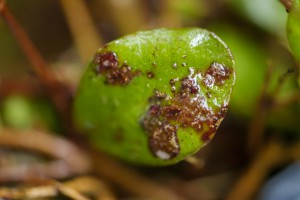
James McCarthy in the field.
Refugia are often thought of in terms of climate change,” says Dr James McCarthy, an ecosystems and conservation researcher at Manaaki Whenua – Landcare Research. “Refugia are areas where a population of plants or animals might still survive under extreme climate pressures.”
While refugia are not often considered in the context of invasive diseases, the same principles apply. A species may persist if it lives in an area that does not support the disease.
“Where these refugia occur will be different for each species,” says McCarthy, “since each species requires slightly different conditions to survive and thrive.”
McCarthy and colleagues used the New Zealand National Vegetation Survey Databank to determine where myrtles occur and what conditions support which myrtle species. They then used soil, climate and landscape variables to model the full habitat range of each species in New Zealand. Of the 27 Myrtaceae trees, shrubs and vines native to New Zealand, the team was able to gather enough data to establish comprehensive species range predictions for 13 of the species.
Then, they compared how the habitat range of each species overlaps with the likely range of myrtle rust in New Zealand under two scenarios – a ‘core distribution’ scenario representing places where the environment is most suitable for infection and a ‘more severe’ scenario representing the entire known distribution of myrtle rust. Doing this allowed them to identify areas for each myrtle species that could serve as refugia from disease.
“Some species have adequate refugia,” says McCarthy. “Species like southern rātā (Metrosideros umbellata) are almost entirely outside of the predicted extent of myrtle rust.”
For other species, there are few existing refugia.
“This is the case with species like ramarama (Lophomyrtus bullata), which has only 15 km2 of refugia, and swamp maire (Syzygium maire), which has only 1.4 km2 of refugia.”
These refugia could be supplemented with ‘restorable refugia’ – areas that are currently deforested but could become refugia through habitat restoration efforts. McCarthy and colleagues have identified several restorable refugia for different species. However, there are still some species that have neither refugia nor restorable refugia, as their entire probable range overlaps with the predicted range of the disease. For these species, alternative conservation measures may be required.
McCarthy and colleagues have recently published their findings in the Journal of Applied Ecology. Their results will be helpful in informing conservation efforts, including maintaining currently protected refugia, restoring potential refugia, and coming up with alternative conservation methods for species with few refugia options. The results will also underpin work to establish how stable these refugia might be in the face of climate change.
Key contact


